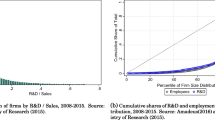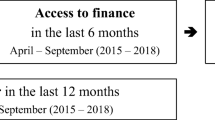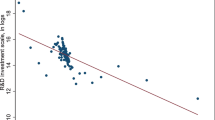Abstract
This study tests for financial constraints on R&D investment and how they differ from capital investment. To identify constraints in the access to external capital, we employ a credit rating index. Our models show that internal constraints, measured by mark-ups, are more decisive for R&D than for capital investment. For external constraints, we find a monotonic relationship between the level of constriction and firm size for both types of investment. Thus, external constraints turn out to be more binding with decreasing firm size. On the contrary, we do not find such monotonic relationships for internal constraints. Differentiation by firms’ age does not support lower constraints for older firms.
Similar content being viewed by others
Notes
Stein (2003) provides an overview on the body of literature on how asymmetric information and other agency problems influence corporate investment in general. While there is a large body of research on investment in physical assets, the special case of R&D investment is less thoroughly investigated.
The questionnaire changes every year, and unfortunately the years 1999 and 2000 cannot be used in this study as relevant variables were not part of the survey in these years.
R&D expenditure and capital investment are measured in million “Deutsche Mark” (1 DM ≈ 0.51 EUR).
It should be noted that we use an inverted version of the original rating index for easier interpretation of the estimated effects. The original index ranges from 100 to 600, where 600 represents the worst rating. We simply switch it around so that higher values of the regressor stand for an improved rating. Further, we divided the rating by 100 in the regression models.
We ran all regressions without adding R&D back to PCM. The results were basically identical to the ones reported below.
References
Acs, Z., & Audretsch, D. (1990). Innovation and small firms. Boston: MIT Press.
Alderson, M., & Betker, B. (1996). Liquidation costs and accounting data. Financial Management, 25(2), 25–36.
Audretsch, D. (2006). Entrepreneurship, innovation, and economic growth. Chaltham: Edward Elgar Publishing.
Audretsch, D., & Elston, J. A. (2002). Does firm size matter? Evidence on the impact of liquidity constraints on firm investment behavior in Germany. International Journal of Industrial Organization, 20, 1–17.
Berger, A., & Udell, G. (2002). Small business credit availability and relationship lending: The importance of bank organizational structure. Economic Journal, 112, 32–53.
Bhagat, S., & Welch, I. (1995). Corporate research and development investments -international comparisons. Journal of Accounting and Economics, 19, 443–470.
Bond, S., Harhofff, D., & Van Reenen, J. (2006). Investment, R&D and financial constraints in Britain and Germany. Annales d’Économie et de Statistique, forthcoming.
Bougheas, S., Görg, H., & Strobl, E. (2003). Is R&D financially constrained? Theory and evidence from Irish manufacturing. Review of Industrial Organization, 22(2), 159–174.
Carpenter, R., & Petersen, B. (2002). Capital market imperfections, high-tech investment, and new equity financing. The Economic Journal, 112, 54–72.
Chiao, C. (2002). Relationship between Debt, R&D and physical investment, evidence from U.S. firm-level data. Applied Financial Economics, 12, 105–121.
Chung, K., & Wright, P. (1998). Corporate policy and market value: A q-theory approach. Review of Quantitative Finance and Accounting, 11(3), 293–310.
Collins, N. R., & Preston, L. E. (1969). Price-cost margins and industry structure. Review of Economics and Statistics, 51(3), 271–286.
Czarnitzki, D. (2006). Research and development in small- and medium-sized enterprises: The role of financial constraints and public funding. Scottish Journal of Political Economy, 53(3), 257–335.
Czarnitzki, D., & Kraft, K. (2004). Management control and innovative activity. Review of Industrial Organization, 24(1), 1–24.
Czarnitzki, D., & Kraft, K. (2007). Are credit ratings valuable information? Applied Financial Economics, 17(13), 1061–1070.
Czarnitzki, D., & Kraft, K. (2008). Capital control, debt financing and innovative activity. Journal of Economic Behavior and Organization, forthcoming.
Fazzari, S., Hubbard, R., & Petersen, B. (1988). Financing constraints and corporate investment. Brookings Papers on Economic Activity, 1988(1), 141–206.
Fazzari, S., Hubbard, R., & Petersen, B. (2000). Investment-cash flow sensitivities are useful: A comment on kaplan and zingales. The Quarterly Journal of Economics, 115(2), 695–705.
Fritsch, M., Brixy, U., & Falck, O. (2006). The effect of industry, region and time on new business survival––A multi-dimensional analysis. Review of Industrial Organization, 28, 285–306.
Gompers, P., & Lerner, J. (1999). The venture capital cycle. Cambridge MA: MIT Press.
Greene, W. H. (2000). Econometric analysis (4th ed.). New Jersey: Prentice-Hall.
Hall, B. (1992). Research and development at the firm level: Does the source of financing matter? NBER Working Paper No. 4096.
Hall, B. (2002). The financing of research and development. Oxford Review of Economic Policy, 18(1), 35–51.
Harhoff, D. (1998). Are there financing constraints for R&D and investment in German manufacturing firms? Annales d’Economie et de Statistique 49/50, pp. 421–456.
Himmelberg, C., & Peterson, B. (1994). R&D and internal finance: A panel study of small firms in high-tech industries. Review of Economics and Statistics, 76, 38–51.
Jensen, M. C. (1986). Agency costs of free cash flow, corporate finance, and takeovers. American Economic Review, 76, 323–329.
Jensen, M. C. (1993). The modern industrial revolution, exit, and failure of internal control systems. Journal of Finance, 48, 831–880.
Kaplan, S., & Zingales, L. (1997). Do investment-cash flow sensitivities provide useful measures of financing constraints? The Quarterly Journal of Economics, 112(1), 169–215.
Kaplan, S., & Zingales, L. (2000). Investment-cash flow sensitivities are not valid measures of financing constraints. The Quarterly Journal of Economics, 115(2), 707–712.
Licht, G., & Nerlinger, E. (1998). New technology-based firms in Germany: A survey of the recent evidence. Research Policy, 26, 1005–1022.
Martinelli, C. (1997). Small firms, borrowing constraints, and reputation. Journal of Economic Behavior & Organization, 33, 91–105.
Mulkay, B., Hall, B., & Mairesse, J. (2001). Investment and R&D in France and in the United States. In D. Bundesbank (Ed.), Investing today for the world of tomorrow. Germany: Springer Verlag.
Müller, E., & Zimmermann, V. (2008). The importance of equity finance for R&D activity––Are there differences between young and old companies? Small Business Economics, forthcoming.
Myers, S., & Majluf, N. (1984). Corporate financing and investment decisions when firms have information that investors do not. Journal of Financial Economics, 13, 187–221.
OECD/Eurostat. (1997). OECD proposed guidelines for collecting and interpreting technological innovation data—Oslo manual. Paris: OECD.
Petersen, M., & Rajan, R. (1995). The effect of credit market competition on lending relationships: Evidence from small business data. Journal of Finance, 49, 3–37.
Ravenscraft, D. J. (1983). Structure-profit relationships at the line of business and industry level. Review of Economics and Statistics, 65, 22–31.
Ritter, J. (1991). The long-run performance of initial public offerings. Journal of Finance, 46, 3–27.
Schumpeter, J. A. (1934). The theory of economic development. Cambridge: Harvard University Press.
Schumpeter, J. A. (1939). Business cycles: A theoretical, historical and statistical analysis of the capitalist process. New York: McGraw-Hill.
Schumpeter, J. A. (1942). Capitalism, socialism and democracy. New York: Harper and Row.
Stein, J. C. (2003). Agency information and corporate investment. In G. M. Constantinides, M. Harris, & R. M. Stulz (Eds.), Handbook of the economics of finance (Vol. 1A). Amsterdam: Elsevier North Holland.
Stulz, R. M. (1990). Managerial discretion and optimal financing policies. Journal of Financial Economics, 26, 3–27.
Wissenschaftsstatistik GmbH im Stifterverband für die Deutsche Wirtschaft (eds) (1999). Forschung und Entwicklung in der Wirtschaft 1997–1999, Essen.
Wooldridge, J. M. (2002). Econometric analysis of cross section and panel data. Cambridge, Massachusetts: MIT Press.
Acknowledgments
We are grateful to the team members of the Mannheim Innovation Panel at the Centre for European Economic Research (ZEW) for providing the survey data and to Creditreform for the rating data. We also thank Jürgen Moka for his help in data processing as well as two anonymous referees and the editor for helpful comments.
Author information
Authors and Affiliations
Corresponding author
Appendix
Appendix
Rights and permissions
About this article
Cite this article
Czarnitzki, D., Hottenrott, H. R&D investment and financing constraints of small and medium-sized firms. Small Bus Econ 36, 65–83 (2011). https://doi.org/10.1007/s11187-009-9189-3
Accepted:
Published:
Issue Date:
DOI: https://doi.org/10.1007/s11187-009-9189-3




